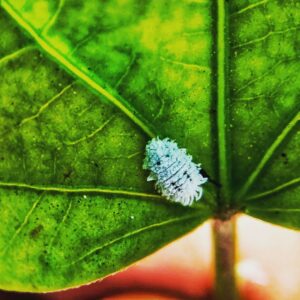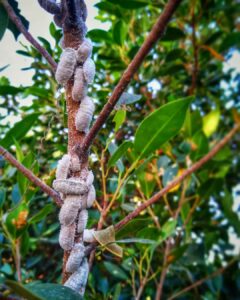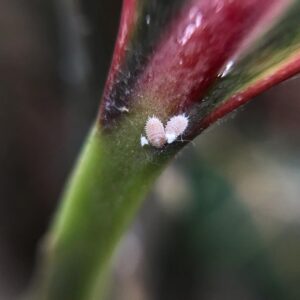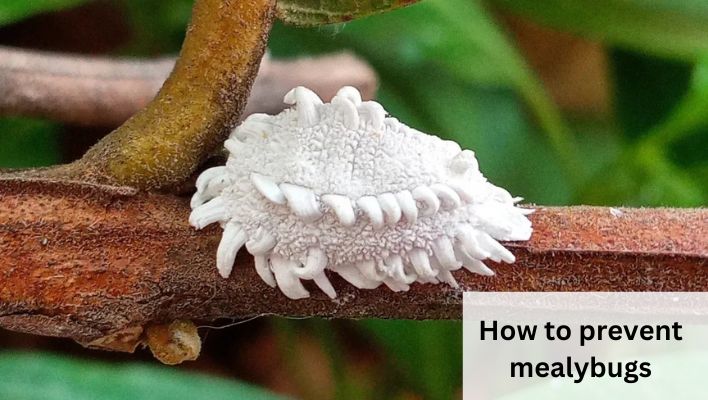Mealybugs are pesky little pests that can wreak havoc on your beloved plants. These small insects, often resembling tiny balls of cotton, may seem harmless at first, but they can quickly multiply and cause serious damage to your greenery.
That’s why it’s crucial to understand how to prevent mealybug infestations and take proactive measures to keep them at bay.
Preventing mealybug infestations is not only about maintaining the health and beauty of your plants; it’s also about protecting them from potential devastation.
Mealybugs have a notorious reputation for sucking the sap out of plants, which weakens them and stunts their growth.
Moreover, these tiny intruders leave behind a sticky residue called honeydew, which attracts ants and can lead to the growth of sooty mold, further compromising your plants’ health.
Below, we’ll delve into the world of mealybugs, explore the signs of infestation, and equip you with effective preventive techniques. By implementing these strategies, you can ensure the longevity and vitality of your plants, while keeping these unwanted visitors at bay.
Understanding Mealybugs
Before we jump into prevention techniques, let’s take a closer look at what mealybugs are and why they can be such a nuisance. Mealybugs are small insects, usually about 1/8 to 1/4 inch in size, that belong to the scale insect family.
They are notorious for their cottony white appearance, which gives them a fluffy, mealy-like texture. These tiny pests primarily feed on the sap of plants, siphoning away vital nutrients and causing considerable damage over time.

Mealybugs reproduce at a rapid rate, with females laying eggs in clusters, often hidden in the nooks and crannies of plants. These eggs hatch into nymphs, which then mature into adult mealybugs. Once they find a suitable feeding spot, they settle in and can multiply quickly, creating a full-blown infestation if not addressed promptly.
Plants Most Susceptible to Mealybug Infestations
While mealybugs can potentially infest various types of plants, certain plants tend to be more susceptible to their attacks. Here are some plants that mealybugs commonly target:
- Houseplants: Mealybugs thrive in the warm and often sheltered environment of indoor spaces, making houseplants prime targets. Plants such as African violets, orchids, ferns, and cacti are frequently affected by mealybug infestations.
- Ornamental Plants: Many ornamental plants in gardens and landscapes are prone to mealybug attacks. Roses, begonias, azaleas, hibiscus, and citrus trees are among the favorites of these pesky insects.
- Greenhouse Plants: Greenhouses provide a favorable environment for mealybugs due to the controlled temperature and humidity levels. Plants commonly grown in greenhouses, such as tomatoes, cucumbers, and peppers, are often at risk of mealybug infestations.
- Succulents: Mealybugs find succulent plants, including cacti and other fleshy species, particularly attractive. The crevices and tight spaces between succulent leaves provide ideal hiding spots for these insects.
It’s important to note that while these plants are more susceptible to mealybugs, these pests can infest a wide range of other plant species as well. Therefore, regardless of the type of plants you have, it’s crucial to be vigilant and take preventive measures to protect them from mealybug infestations.
Signs of Mealybug Infestation
Detecting a mealybug infestation early is essential for effective control. Here are some signs to look out for to identify if your plants are being attacked by these pesky pests.
Identifying Physical Symptoms in Plants
- Yellowing Leaves: One of the common signs of a mealybug infestation is the yellowing of leaves. Mealybugs extract sap from plants, depriving them of essential nutrients. As a result, the affected leaves may turn yellow, wilt, or even drop prematurely.
- Stunted Growth: If you notice that your plants are not growing as vigorously as they should, mealybugs could be the culprit. These pests weaken the plants by feeding on their sap, leading to stunted growth and a lack of vitality.
- Distorted Shoots and Leaves: Mealybugs extract sap from tender shoots and young leaves, causing them to become distorted or deformed. You may notice curling, puckering, or misshapen growth on affected plants.
- Honeydew and Sooty Mold: Mealybugs excrete a sugary substance called honeydew, which often accumulates on the leaves and stems of infested plants. This sticky residue can attract ants and promote the growth of a black, sooty mold fungus. If you see a sticky or blackish coating on your plants, it may indicate a mealybug infestation.

Recognizing the Presence of Mealybugs
- Visible Mealybugs: In some cases, you may spot the mealybugs themselves on the surface of plants. These insects are small, soft-bodied, and covered in white, powdery wax. They may gather in clusters or hide in protected areas, such as leaf axils, where they are less visible.
- Cottony Masses: Look for cottony or fluffy masses on the leaves, stems, or leaf axils of your plants. These are the egg sacs and protective coverings created by female mealybugs to safeguard their eggs and nymphs. The cottony masses may vary in size and appearance depending on the species.
- Ant Activity: Mealybugs produce honeydew, a sweet substance that ants find irresistible. If you notice an influx of ants around your plants, it could indicate the presence of mealybugs, as the ants are attracted to the honeydew secreted by the pests.
By keeping an eye out for these signs and regularly inspecting your plants, you can catch mealybug infestations early on and take appropriate measures to prevent them from spreading further.
How to Prevent Mealybugs
Preventing mealybug infestations is crucial to maintaining the health and vitality of your plants. Here are various methods you can employ to keep these pesky pests at bay:
Cultural Practices:
- Proper Plant Care: Healthy plants are less susceptible to mealybug infestations. Ensure your plants receive adequate sunlight, water, and nutrients. Avoid overwatering, as excessively moist conditions can attract mealybugs.
- Plant Placement: Position your plants in areas with good airflow and sunlight. Mealybugs thrive in humid environments, so providing proper ventilation can discourage their presence. Additionally, keep new plants isolated for a few weeks before introducing them to your existing plant collection to prevent the spread of potential infestations.
- Regular Inspection: Regularly inspect your plants for any signs of mealybugs or their cottony masses. Pay close attention to the undersides of leaves, leaf axils, and tight crevices where these pests often hide. Early detection allows for prompt action to prevent the infestation from spreading.
Natural Remedies:
- Horticultural Oils: Horticultural oils, insecticidal soap, can be effective in suffocating mealybugs. Dilute the oil according to the manufacturer’s instructions and apply it to the affected areas of your plants. Ensure thorough coverage of both upper and lower leaf surfaces.
- Neem Oil: Neem oil is a natural insecticide derived from the neem tree. It has insecticidal properties that can deter and control mealybugs. Mix neem oil with water and apply it to your plants, following the instructions on the product label. Be consistent with applications to maintain efficacy.
- Biological Controls: Introduce natural predators of mealybugs, such as ladybugs, lacewings, or predatory mites, to your garden or greenhouse. These beneficial insects feed on mealybugs and can help control their populations. Creating an environment that supports these beneficial insects, such as planting nectar-rich flowers, can encourage their presence.
Pruning and Sanitation:
- Prune Infested Parts: If you notice mealybugs on your plants, promptly prune and remove the infested parts. This helps to prevent the spread of the pests to other areas of the plant and neighboring plants.
- Dispose of Infested Material: Seal the pruned plant material in a plastic bag and dispose of it properly. This prevents mealybugs from reinfesting your plants or spreading to other plants.
- Clean Plant Containers: Mealybugs can hide in plant containers and potting soil. Regularly clean and sanitize your plant containers to remove any mealybug eggs or nymphs. Consider using a mild bleach solution (1 part bleach to 9 parts water) for cleaning.
Water Management:
- Avoid Overwatering: Mealybugs thrive in moist conditions. Avoid overwatering your plants, as it creates a favorable environment for these pests. Allow the topsoil to dry out slightly before watering again.
- Bottom Watering: Instead of watering from above, consider bottom watering your plants. This involves placing the plant pot in a tray filled with water and allowing the plant to absorb water from the bottom. This method helps to keep the foliage dry and minimizes the risk of mealybug infestations.
Quarantine New Plants:
When acquiring new plants, especially those from unknown sources, it’s crucial to quarantine them for a few weeks.
This allows you to closely monitor the plants for any signs of mealybugs or other pests before introducing them to your existing plant collection.

Physical Removal:
If you spot individual mealybugs on your plants, you can manually remove them using a cotton swab dipped in rubbing alcohol or a solution of dish soap and water.
Gently dab the affected areas to eliminate the pests. Be thorough in your efforts to remove all visible mealybugs.
Avoid Excessive Fertilization:
Mealybugs are attracted to plants with high nitrogen levels, which are often a result of excessive fertilization.
Avoid overfertilizing your plants, as it can make them more susceptible to mealybug infestations. Follow the recommended fertilizer application guidelines for your specific plants.
Introduce Beneficial Insects:
- Parasitic Wasps: Certain species of parasitic wasps, such as Anagyrus pseudococci or Leptomastix dactylopii, are natural enemies of mealybugs. These tiny wasps lay their eggs inside mealybugs, effectively controlling their populations. Consider releasing these beneficial insects in your garden or greenhouse.
- Predatory Beetles: Lady beetles (ladybugs) and their larvae feed on mealybugs and can be an effective biological control. Release them in areas with mealybug infestations to help reduce their numbers.
Use Sticky Traps:
Place sticky traps near your plants to catch adult mealybugs and prevent them from reaching your plants to lay eggs.
These traps consist of yellow or blue sticky cards or tapes that attract and trap flying mealybugs. Regularly monitor and replace the traps as needed.
Remove Weeds and Debris:
Mealybugs can infest weeds and plant debris in and around your garden, providing a hiding place and a potential source of infestation.
Remove weeds promptly and clean up fallen leaves and plant debris to minimize the risk of mealybugs spreading to your cultivated plants.
Soil Sterilization:
If you’re dealing with persistent mealybug infestations in potted plants, consider sterilizing the potting soil before replanting.
This can help eliminate any mealybug eggs or nymphs present in the soil. Methods for soil sterilization include baking the soil in the oven or treating it with steam.
Companion Planting:
Some plants act as natural repellents to mealybugs. Consider incorporating companion plants such as garlic, chives, marigolds, or catnip around your susceptible plants.
These companion plants can help deter mealybugs with their natural scents or repellent properties.
Regularly Inspect New Plant Purchases:
Before bringing new plants into your home or garden, thoroughly inspect them for any signs of mealybugs or other pests.
Look closely at the foliage, stems, and undersides of leaves. If you spot any mealybugs or their cottony masses, avoid purchasing or isolating the plants until you can address the infestation.
Chemical Control:
If natural remedies and cultural practices do not effectively control the mealybug infestation, you may consider using chemical insecticides as a last resort.
It’s important to choose insecticides labeled specifically for mealybug control and follow the instructions and safety precautions outlined on the product label.
Exercise caution when using chemical control methods, and consider their potential impact on beneficial insects and the environment.
Remember, a combination of different prevention methods tailored to your specific situation will yield the best results in keeping mealybugs at bay.
Organic Pesticides to control mealybugs
When it comes to organic pesticides for controlling mealybugs, there are several effective brands available on the market. Here are three popular options:
Bonide Neem Oil:
Neem oil is derived from the seeds of the neem tree (Azadirachta indica) and is known for its insecticidal and repellent properties.
Bonide Neem Oil is a widely used organic pesticide for mealybug control. It works by disrupting the feeding and reproductive abilities of mealybugs, ultimately leading to their demise.

Apply the solution evenly to all plant surfaces, focusing on the areas with mealybug infestations. Repeat the application as needed, usually at weekly intervals, to ensure continuous control.
Monterey Garden Insect Spray:
Monterey Garden Insect Spray is an OMRI-listed organic pesticide that effectively targets a range of pests, including mealybugs. It contains active ingredients such as spinosad, derived from naturally occurring soil bacteria, which affects the nervous system of pests.

Following the instructions on the label thoroughly spray the infested plants, ensuring complete coverage of all plant surfaces. Repeat the application as necessary, typically at 7-14 day intervals, depending on the severity of the infestation.
Safer Brand Insect Killing Soap
Safer Brand Insect Killing Soap is a popular choice for organic pest control, including mealybugs. It contains potassium salts of fatty acids, which work by breaking down the protective coating of mealybugs, leading to dehydration and ultimately their demise.

Dilute the Safer Brand Insect Killing Soap concentrate according to the instructions on the label. Apply the solution to the affected plants, covering all plant surfaces where mealybugs are present. Repeat the application as required, usually at 7-10 day intervals, until the infestation is under control.
It’s important to carefully read and follow the instructions provided by the pesticide manufacturer to ensure proper application and safety. Always consider the specific needs and requirements of your plants, as well as any potential impacts on beneficial insects and the environment. When using any pesticide, organic or otherwise, it’s advisable to perform a small test application on a few leaves before treating the entire plant to assess any potential adverse effects.
How to prevent mealybugs FAQs
How do mealybugs spread?
Mealybugs can spread through various means. They can crawl from one plant to another, especially when the plants are close.
Mealybugs can also be transported by wind or carried by insects, birds, or even humans. Moreover, they can infest new plants if they are introduced into your garden or home without proper inspection and quarantine.
Are mealybugs harmful to humans?
Mealybugs are not known to directly harm humans. They do not bite or sting and are not considered a health hazard.
However, it is important to note that mealybugs can cause indirect harm by damaging and weakening plants, leading to reduced vitality and aesthetic appeal.
Additionally, some people may experience skin irritation or allergic reactions if they come into contact with the waxy secretions produced by mealybugs.
Can mealybug infestations be prevented entirely?
While it is challenging to completely prevent mealybug infestations, it is possible to significantly reduce the risk through proactive measures.
By implementing proper plant care practices, regularly inspecting plants for signs of infestation, practicing good sanitation, and employing natural deterrents, you can create an environment that discourages mealybugs.
Early detection and prompt action are key to preventing infestations from spreading and causing significant damage.
What should I do if my plants are already infested?
If you discover that your plants are already infested with mealybugs, it is important to take immediate action to prevent further damage. Here are some steps to follow:
- Isolate Infested Plants: Move the infested plants away from other healthy plants to prevent the mealybugs from spreading.
- Prune Infested Parts: Carefully prune and remove the heavily infested parts of the plant. Seal the pruned material in a plastic bag and dispose of it properly.
- Use Natural Remedies: Apply organic pesticides, such as neem oil or insecticidal soap, to the affected plants. Follow the instructions on the product label for proper dilution and application.
- Introduce Beneficial Insects: Consider releasing natural predators of mealybugs, such as ladybugs or predatory mites, to help control the infestation.
- Monitor and Repeat: Regularly monitor the infested plants for any signs of mealybugs. Repeat the necessary treatments and inspections to ensure effective control.
- Practice Preventive Measures: Once the infestation is under control, continue implementing preventive measures to minimize the risk of future infestations.
Conclusion
Preventing mealybug infestations is essential for maintaining the health and beauty of your plants. By understanding what mealybugs are, recognizing the signs of infestation, and implementing preventive measures, you can significantly reduce the risk of these pests wreaking havoc on your cherished greenery.
Cultural practices such as proper plant care, strategic plant placement, and regular inspections play a vital role in preventing mealybug infestations.
Creating a healthy and well-ventilated environment for your plants can deter these pests from taking hold. Additionally, incorporating natural remedies like horticultural oils, neem oil, and biological controls can provide effective and eco-friendly solutions.
When preventive measures fall short and your plants become infested, it is important to take immediate action.
Isolating the infested plants, pruning affected parts, and using natural remedies can help control the infestation and prevent further damage. Introducing beneficial insects and monitoring the situation closely are crucial steps in regaining control.
While it may be challenging to eliminate the risk of mealybug infestations, with vigilance and proactive measures, you can minimize their impact and protect your plants.
Regularly inspect new plant purchases, maintain good sanitation practices, and implement a combination of preventive methods to create an environment that is less favorable to mealybugs.
Remember, prevention is key. By implementing these strategies and staying alert to the signs of infestation, you can ensure the long-term health and vitality of your plants.
With a proactive approach and the right knowledge, you can confidently combat mealybugs and enjoy a thriving garden or indoor plant collection.
